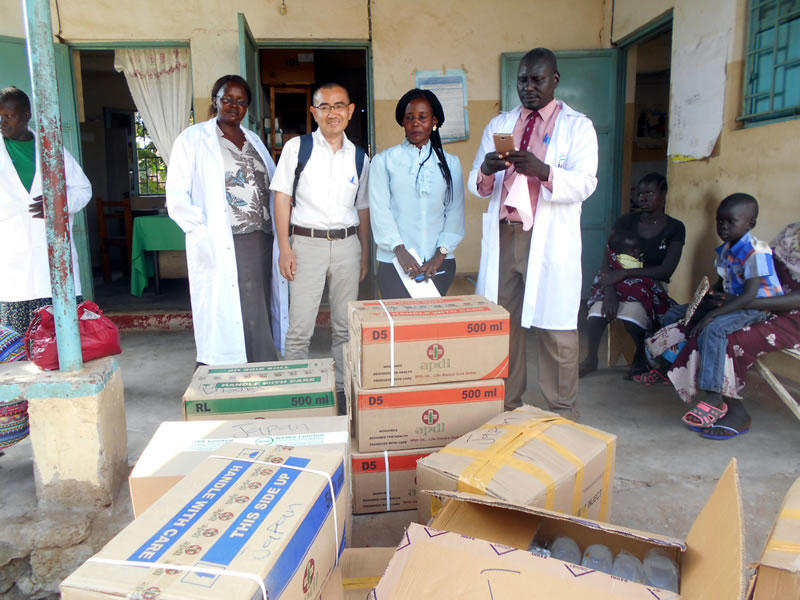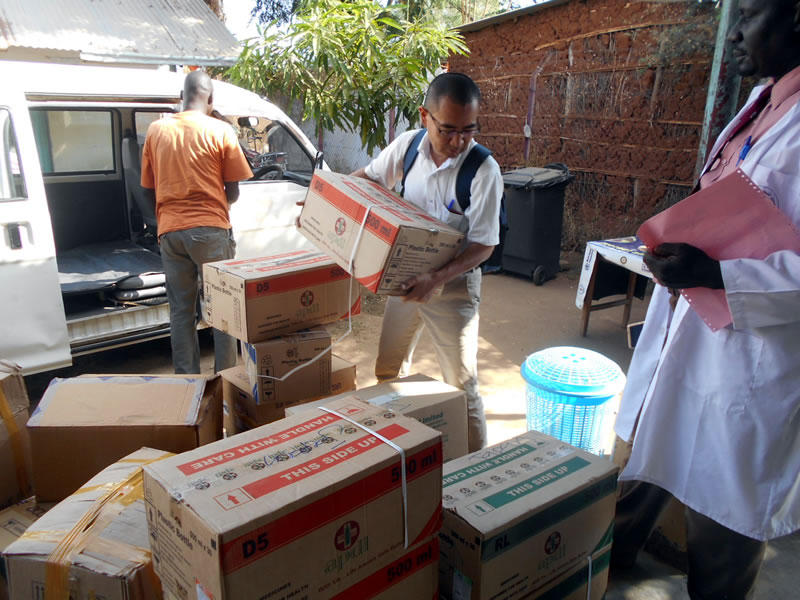– Support of medical supplies such as medicines for malaria to the Gumbo clinic –
[Original by Takaki IMAI, Manager for Humanitarian Assistance and Peace-Building Group (December 8, 2017); Translated by K. Adachi]
I went to Juba in South Sudan on November 23, 2017, listened to the internally displaced people in refugee camps, and gave medical and educational aid. I will report the local situations and our activities in this series, “The Diary from South Sudan.”
The 6th day: 28th of November (Tuesday)
Support of medical supplies to the Gumbo clinic
I went to the Gumbo clinic and had a meeting with Dr. Remo. We selected which medical supplies were highly required within our limited budget. We decided the wholesaler after we compared the quotations obtained from three different wholesale companies, and ordered supplies according to the medical supply list from Dr. Remo. We are going to receive the supplies tomorrow morning and deliver them to the clinic.
The 7th day: 29th of November (Wednesday)
Office of Caritas South Sudan in the Juba parish
I visited the office of Caritas South Sudan, an organization with which JVC cooperates, in the Juba parish. I reported to Mr. Ben, who is the new representative, that I had a meeting with the doctor in Gumbo clinic yesterday, and I had procured medical supplies. As I wanted to hand medical supplies over today, he let the staff in charge of health accompany us as an observer.
Delivery of medical supplies to the Gumbo clinic
I dropped by the wholesaler close to Konyo Konyo market along the Nile River in order to load 17 cases of medical supplies and went across the river and headed to the clinic directly. There is a checkpoint after crossing the Nile River. The inspector could mark more than necessary if foreigners are in the car, and there is the possibility that an inspection could take loads of time. Therefore, I didn’t get in the car together with the supplies, and I followed behind in a taxi. This is the usual way when we deliver relief supplies. The car loading medical supplies and the staff from Caritas was stopped at the checkpoint for ordinary questioning and we went through safely and arrived at the clinic.
This time we supported 23 kinds of medicines with a focus on medicines for malaria and antibiotics. The medicine for malaria is the most important one in South Sudan, where malaria prevails. It will save the lives of many children.

(From the left) A staff member of the Gumbo clinic, Imai of JVC, the person in charge of health from Caritas, and Dr. Remo.
Dr. Remo, the chief of the clinic, confirmed the contents of medicines and signed the certificate of delivery. The staff of Caritas signed it as a witness.
Visit to the Mangaten refugee Camp 2
We crossed the Nile River and returned to Juba then went to the Mangaten domestic refugee camp in the afternoon. When we visited Camp 2, the Red Cross in South Sudan just started the distribution of daily commodities. Because the most of refugees gathered in the distribution place, we changed our plan of hearing to the people living tents and discussed with teachers of the elementary school about the support of school goods.
The formal name of the elementary school is “Theore Gatkul elementary school.” It was originally a municipal elementary school managed by collecting tuition from students. In December 2013, however, street fighting occurred in Juba, the whole neighborhood evacuated, and the school was closed. After that, the refugee camp was established in this place in 2015. Voluntary teachers resumed the school to teach children in the camp. At present about ten voluntary teachers of refugees are managing the school.
After listening to the introduction of the elementary school, we asked about the number of school children. There are 9 classes from nursery class to the 8th grade. The number of children decreases in upper classes. For example, the number of the 8th grade students is about one fifth in comparison with the 1st grade.
The worst problem is the number of female students. There are comparable numbers of students in the nursery class, 146 boys and 155 girls. Meanwhile, there are 77 boys and 31 girls in the 5th grade, and 35 boys and only 19 girls in the 8th grade. As we asked the principal about the reason why female students stop attending the school, he answered, “Mothers force them to engage in the work of cleaning, washing and drawing water.”
It is said that the total number of school children is 1,376, but the number of children who actually attend the class seems to be 50 to 60 children per class in lower grades and 30 to 40 children per class in upper grades. It means that the actual number of total students is about 400.
The 1,376 people are the number of registered students at the beginning of a school year. I guess that every family registers their children because the school tuition is free, but they can’t continue sending children to the school.
Although the school tuition is free, each family must purchase school goods. Five notebooks are necessary because there are 5 subjects in the elementary school, but I hear that most of children bring only one notebook. Some children don’t have school goods at all and just sit during classes. I asked a question, “How much does it cost to buy a notebook in a stationary store?” The answer was, “It costs about 200 South Sudanese Pounds (SSP).”
This answer surprised me. If converted to USD, it is about 1 USD. It is a sort of exercise notebook of size A5. If we buy such a notebook of the same quality in Japan, 100 Japanese Yen will be enough to buy several ones. The price standard of imported goods has greatly soared in Juba, because the transportation cost is quite high including the risk of security during continued civil war. There are almost no domestic industrial products except for bottled drinking water. If women do day labors in a market in Juba, the daily payment is about 150 SSP. It means they cannot buy a notebook even if they work for a whole day.
After carrying out the hearing above, we discussed towards the distribution of school goods; what kinds of basic items are necessary for children, how many pieces we should supply per child, how many children we should target, and so on. We decided the target to be 500 people. While we target children who are currently attending the school, we also include children who don’t have school supplies and cannot attend the school (children who are registered but don’t attend the school in fact). The day of distribution will be December 5, 2017 (Tuesday).
Visit to the Mangaten refugee Camp 1
Next we moved to Camp 1. We had a meeting with Mr. Wadar, the principal of the elementary school (DMI elementary school), discussing about the contents of school supplies and the date of distribution. We are planning the distribution after the new semester begins.
In next report, I will report the status of hearing and procurement of school supplies in the Mangaten domestic refugee Camp 2.
Share This:
